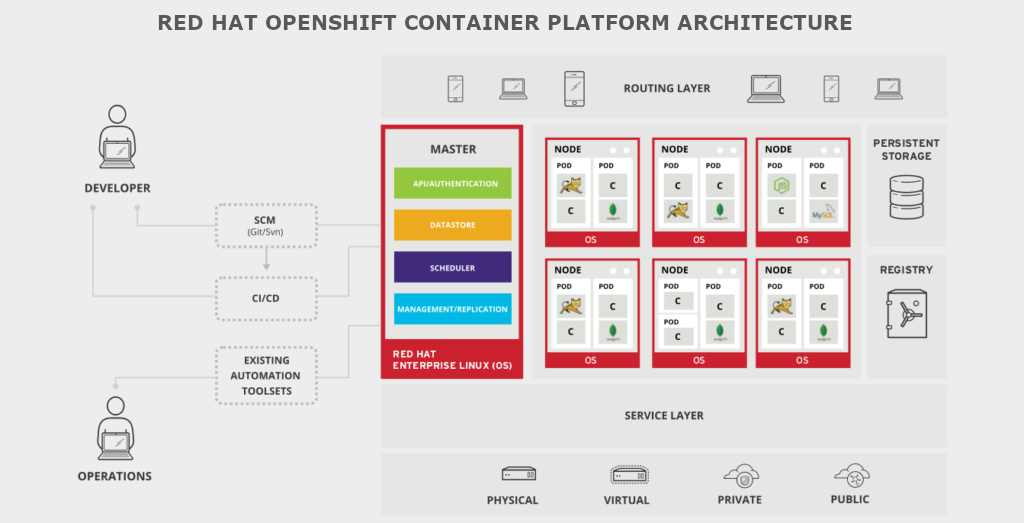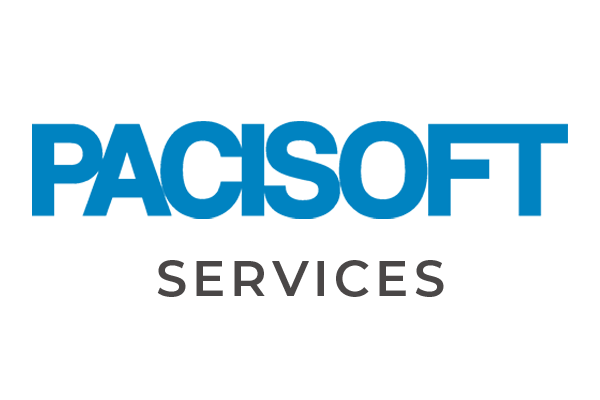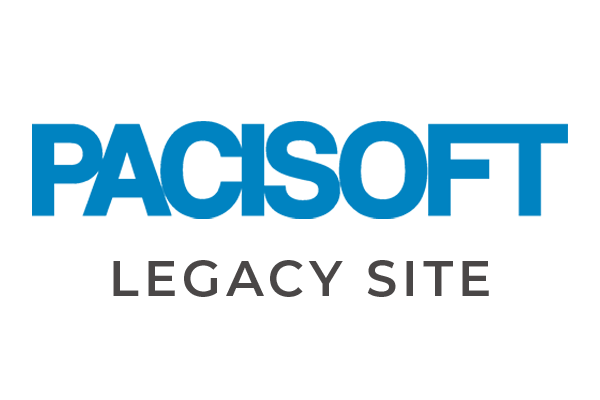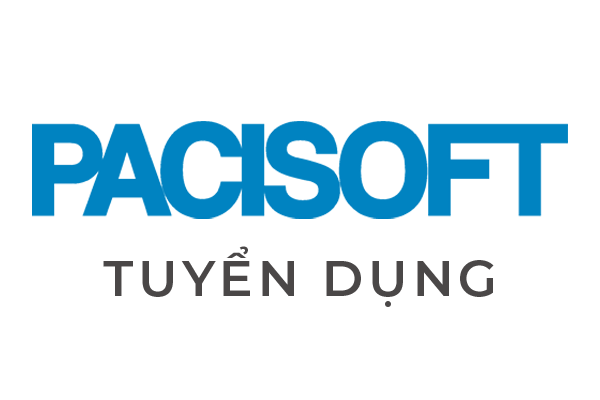Red Hat OpenShift Container Platform
Red Hat OpenShift Container Platform là nền tảng đám mây kết hợp nhất quán để xây dựng và mở rộng quy mô các ứng dụng được chứa trong vùng chứa.
- Tăng tốc phát triển và phân phối ứng dụng.
- Nâng cấp tự động, dễ dàng giống như đám mây.
- Nền tảng nhất quán cho khối lượng công việc tại chỗ và đám mây công cộng.
☛ Sản phẩm có thể có nhiều Edition và thông số khác nhau.
Thông tin
- Dành cho doanh nghiệp
- Thời hạn bản quyền: Thuê bao
-
Tổng quan
-
Tính năng
-
So sánh
-
Thông số
-
Cấp phép
-
Yêu cầu hệ thống
-
Download
RedHat – một công ty phần mềm của Mỹ, là nhà cung cấp hệ điều hành Linux thương mại lớn nhất thế giới. Chuyên cung cấp sản phẩm phần mềm mã nguồn mở cho cộng đồng doanh nghiệp. Tên tuổi của RedHat gắn liền với hệ điều hành doanh nghiệp Red Hat Enterprise Linux. RedHat cũng cung cấp nền tảng hệ điều hành, middleware, các ứng dụng, sản phẩm quản lý và hỗ trợ, đào tạo và dịch vụ tư vấn. Red Hat đã tạo ra, duy trì và đóng góp cho nhiều dự án phần mềm miễn phí.
Tuy nhiên, cuối năm 2018, IBM đã mua lại Red Hat và trở thành nhà cung cấp đám mây lai số 1 thế giới. IBM và Red Hat hợp nhất sẽ giúp khách hàng tạo ra các ứng dụng doanh nghiệp từ đám mây nhanh hơn, mang lại khả năng di động và bảo mật dữ liệu và ứng dụng cao hơn trên nhiều đám mây công cộng và đám mây riêng, với một hệ thống quản lý đám mây nhất quán.
Red Hat OpenShift là một nền tảng dịch vụ đám mây phát triển ứng dụng (PaaS) được xây dựng trên nền tảng mã nguồn mở Kubernetes. Được phát triển bởi Red Hat, một công ty công nghệ và dịch vụ phần mềm nổi tiếng, OpenShift cung cấp một môi trường phát triển ứng dụng đáng tin cậy và mạnh mẽ cho việc triển khai và quản lý các ứng dụng đám mây.
OpenShift giúp các nhà phát triển xây dựng, triển khai và quản lý các ứng dụng đám mây một cách dễ dàng. Nó cung cấp một số tính năng quan trọng như tự động mở rộng, phân phối tải, khả năng chạy ứng dụng trên nhiều môi trường và cung cấp khả năng mở rộng theo yêu cầu.
OpenShift được xây dựng trên nền tảng Kubernetes, một hệ thống quản lý container phổ biến và mạnh mẽ. Nó sử dụng các khái niệm và công nghệ của Kubernetes để tạo ra một môi trường ứng dụng đám mây linh hoạt và có khả năng mở rộng. OpenShift cung cấp các công cụ và giao diện người dùng dễ sử dụng để triển khai, quản lý và theo dõi các ứng dụng được đóng gói trong các container.
Với OpenShift, người dùng có thể triển khai ứng dụng của mình trên các môi trường đám mây công cộng, riêng tư hoặc hỗn hợp. Nó cung cấp tích hợp dễ dàng với các công cụ phát triển phổ biến như Git, Jenkins và IDE khác. Ngoài ra, OpenShift hỗ trợ nhiều ngôn ngữ lập trình và framework, cho phép các nhà phát triển sử dụng công nghệ yêu thích của họ để phát triển ứng dụng.
Red Hat OpenShift Container Platform là một nền tảng phát triển ứng dụng đám mây (PaaS) mạnh mẽ và linh hoạt. Xây dựng trên nền tảng Kubernetes, OpenShift Container Platform cung cấp một môi trường phát triển ứng dụng đáng tin cậy và có khả năng mở rộng.
Với Red Hat OpenShift Container Platform, người dùng có thể triển khai và quản lý ứng dụng đám mây trên cơ sở hạ tầng đám mây một cách dễ dàng.
Tham khảo thêm
- Phần mềm bản quyền chính hãng, giá tốt có tại Pacisoft với hơn 10,000 sản phẩm nổi tiếng toàn cầu
- Các phần mềm, giải pháp hữu ích từ Red Hat đầy đủ trong danh mục Hệ thống- Hệ điều hành
- Xem các bài viết về RedHat tại đây
- Landing Page Red Hat
- Đừng quên nhấn nút liên hệ để nhận tư vấn & báo giá tại PACISOFT NGAY HÔM NAY!
Red Hat OpenShift Container Platform cung cấp nhiều tính năng nổi bật để hỗ trợ triển khai và quản lý ứng dụng đám mây. Dưới đây là một số tính năng chính:
-
Đám mây đa nền tảng: Red Hat OpenShift Container Platform cho phép triển khai ứng dụng trên các môi trường đám mây công cộng, riêng tư và hỗn hợp. Điều này cho phép người dùng tận dụng các tài nguyên đám mây hiện có và linh hoạt chuyển đổi giữa các môi trường một cách dễ dàng.
-
Quản lý vòng đời ứng dụng: Nền tảng này cung cấp các công cụ và tính năng để quản lý toàn bộ vòng đời của ứng dụng. Người dùng có thể xây dựng, triển khai và quản lý các phiên bản ứng dụng một cách dễ dàng. Các công cụ tích hợp CI/CD giúp tự động hóa quy trình triển khai và đảm bảo sự nhất quán và liên tục trong phát triển ứng dụng.
-
Tự động mở rộng và phân phối tải: OpenShift Container Platform tự động mở rộng ứng dụng dựa trên tải và yêu cầu sử dụng tài nguyên. Nền tảng sử dụng các công cụ và kỹ thuật điều chỉnh tải như Horizontal Pod Autoscaler (HPA) và Kubernetes Event-Driven Autoscaling (KEDA) để đáp ứng nhu cầu mở rộng và phân phối tải một cách linh hoạt.
-
Tích hợp Kubernetes và các công cụ phát triển: Red Hat OpenShift Container Platform được xây dựng trên nền tảng Kubernetes, cho phép người dùng tận dụng các tính năng mạnh mẽ của Kubernetes trong việc quản lý và triển khai ứng dụng. Ngoài ra, nó cũng tích hợp tốt với các công cụ phát triển phổ biến như Jenkins, Tekton và Quay để hỗ trợ quy trình CI/CD và quản lý các ứng dụng container.
-
Bảo mật và kiểm soát truy cập: Red Hat OpenShift Container Platform cung cấp các tính năng bảo mật và kiểm soát truy cập mạnh mẽ. Nền tảng hỗ trợ xác thực người dùng, quản lý quyền truy cập và áp dụng các biện pháp bảo mật.

| Platform | Red Hat OpenShift | Kubernetes Open source container orchestration |
| Push-button, automated node configuration and tools | ✓ | |
| Multi-host-container scheduling | ✓ | ✓ |
| Self-service provisioning | ✓ | ✓ |
| Service discovery | ✓ | ✓ |
| Enterprise container host operating system | ✓ | |
| Container Image registry | ✓ | |
| Validated storage plug-ins | ✓ | |
| Networking and validated plug-ins | ✓ | |
| Monitoring | ✓ | |
| Log aggregation | ✓ | |
| Service Mesh | ✓ | |
| Multitenancy | ✓ | |
| Metering and chargeback | ✓ | |
| Developer experience | ||
| Cloud service broker | ✓ | |
| Automated image builds | ✓ | |
| CI/CD and DevOps workflows and pipelines | ✓ | |
| Validated third-party Kubernetes operators and Helm charts | ✓ | |
| Certified databases and related data services | ✓ | |
| Certified application services | ✓ | |
| 200+ certified ISV solutions | ✓ | |
| Enterprise operations | ||
| Multi-cluster management | ✓ | |
| Zero downtime patching and upgrades | ✓ | |
| Enterprise 24/7 support | ✓ | |
| 9-year support lifecycle | ✓ | |
| Security response team | ✓ | |
| Manufacturer/ Nhà sản xuất | VMware Inc (Mỹ) |
| Header / Localization/ Khu vực kích hoạt | Toàn cầu |
| Category/ Danh mục sản phẩm | Hệ thống- hệ điều hành |
| Part Number (P/N)/ Mã sản phẩm | RHOSCP |
| Collections/ Dòng sản phẩm | OpenShift |
| Packaged Quantity/ Số lượng đóng gói | 1 cho đến nhiều, theo yêu cầu đặt hàng |
| Software / Version/ Phiên bản | Mới nhất |
| Language/ Ngôn ngữ | English/ đa ngôn ngữ |
| Distribution Media/ Đóng gói | Download (ESD) |
| Operating System/ Platform/ Nền tảng sử dụng | Win/Mac |
| Product Type/ Loại sản phẩm | Subscription Có thời hạn gói Support |
| Software / License Type/ Loại giấy phép | New/ Renew/ Upgrade/ Extend/ Maintenance & Support |
| Length of term/ Thời hạn bản quyền | License Lâu dài/ Support 1 – 3 năm hoặc thuê bao |
| License management/ Quản lý bản quyền | Product Key Code |
| Customer secition/ Đối tượng khách hàng | Doanh nghiệp |
| Advanced version/ Phiên bản cao cấp hơn | |
| Comparison/ So sánh sản phẩm | Xem mô tả so sánh hoặc tài liệu đính kèm |
| Service & Support Basic/ Dịch vụ và hỗ trợ cơ bản | Basic by RedHat |
| Service & Support Advance/ Dịch vụ và hỗ trợ nâng cao | Tư vấn hệ thống/ Triển khai cài đặt/ Hỗ trợ 1 năm/ Đào tạo sử dụng |
| How to buy/ Mua như thế nào? | Ký hợp đồng và PACISOFT giao trong 1-7 ngày làm việc (cam kết nhanh nhất Việt Nam) |
| Tax & handling fee/ Thuế VAT & phí xử lý | Phần mềm & dịch vụ phần mềm được miễn thuế VAT. |
| Thuế, phí khác có thể được áp dụng tại thời điểm mua hàng theo quy định của NN. |
Red Hat OpenShift Container Platform
Subscription components:
- Red Hat OpenShift Kubernetes Engine: Each OpenShift Container Platform subscription includes all of the components of OpenShift Kubernetes Engine as well as additional layered services described later in this section.
- Red Hat JBoss® Web Server: OpenShift Container Platform subscriptions include Red Hat JBoss Web Server, an enterprise solution that combines the Apache web server with the Apache Tomcat servlet engine, supported by Red Hat. OpenShift Container Platform includes an unlimited right to use JBoss Web Server. Learn more about JBoss Web Server.
- Red Hat’s single sign-on (SSO) technology: Red Hat provides web SSO and identity federation based on security assertion markup language (SAML) 2.0, OpenID Connect, and Open Authorization (OAuth) 2.0 specifications. This capability, included in OpenShift subscriptions, may only be deployed inside OpenShift environments. Nevertheless, any application—whether deployed inside or outside of OpenShift—may use Red Hat’s SSO.
- Log management: Adds support for log aggregation and management via Elasticsearch and Kibana integrated with Fluentd for log collection.
- Red Hat CodeReady Workspaces: A collaborative Kubernetes-native development environment that delivers OpenShift workspaces and an in-browser integrated development environment (IDE).
- Red Hat build of Quarkus: A full-stack, Kubernetes-native Java framework made for Java virtual machines (JVMs) and native compilation, optimizing Java specifically for containers and allowing it to become an effective platform for serverless, cloud, and Kubernetes environments.
- Web console: Provides an optimized experience for both developers and administrators. The developer perspective grants visibility into application components, and the administrative perspective allows the user to view the OpenShift and Kubernetes resources.
- Red Hat OpenShift Pipelines: Automate and control application delivery across on-premises and public cloud platforms with Kubernetes-native continuous integration/continuous delivery (CI/CD) pipelines based on Tekton.
- Red Hat OpenShift GitOps: An opinionated workflow integrating git repositories, CI/CD tools, and Kubernetes to realize faster, security-focused, scalable software development, without compromising quality, based on Argo CD.
- Red Hat OpenShift Serverless: Event-driven serverless containers and functions that let you deploy and run serverless containers. Powered by a rich ecosystem of event sources, you can manage serverless apps natively in OpenShift. Based on Knative, OpenShift Serverless allows you to run serverless applications anywhere OpenShift runs.
- Red Hat OpenShift Service Mesh: Red Hat OpenShift Service Mesh provides a uniform way to connect, manage, and observe microservice-based applications, including Istio to manage and secure traffic flow across services, Jaeger for distributed tracing, and Kiali to view configuration and monitor traffic
- Red Hat Insights for OpenShift: Red Hat Insights for OpenShift is a set of hosted services on console.redhat.com, included with a Red Hat subscription, that use configuration and usage data sent from your deployments to console.redhat.com, along with rule-based analytical models, to help you track and optimize expenses, improve stability, and enhance performance.
- IBM Cloud Satellite: Red Hat OpenShift Container Platform customers who choose to purchase and deploy the IBM Cloud Satellite solution can use their OpenShift node subscription to entitle the customer workload-related Red Hat OpenShift Kubernetes Service on IBM Cloud clusters located within their datacenter. Customers can call IBM or Red Hat for support, but ultimately the support experience will start with IBM Cloud Satellite support services. This OpenShift subscription usage is only available to customers deploying IBM Cloud Satellite within their datacenter and not in public cloud environments. Cores are counted the same way as explained elsewhere in this detail for normal OpenShift usage.
Xem thêm chi tiết hướng dẫn tại đây:
https://access.redhat.com/documentation/en-us/red_hat_process_automation_manager/7.13/pdf/installing_and_configuring_red_hat_process_automation_manager/red_hat_process_automation_manager-7.13-installing_and_configuring_red_hat_process_automation_manager-en-us.pdf
| Masters |
|
| Nodes |
|
| External etcd Nodes |
|
| Ansible controller | The host that you run the Ansible playbook on must have at least 75MiB of free memory per host in the inventory. |
Download tại đây:
https://access.redhat.com/downloads
TRƯỚC KHI TẢI XUỐNG
Bạn sẽ cần đăng ký hoạt động hoặc dùng thử sản phẩm trước khi tải xuống các sản phẩm của Red Hat.















